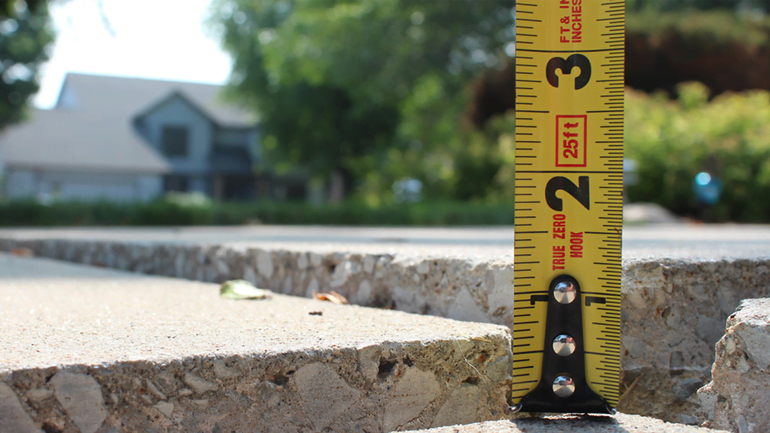Concrete Slab Jacking

Seeing a crack in the concrete in your home will probably set off some of your internal alarm bells. What are you going to do? As it turns out, concrete cracking is not all that uncommon, and in some cases, not serious. If you notice a concrete crack it’s important to identify the type of crack so you can narrow down the possible causes. When the concrete slabs crack, this could eventually lead to the slabs moving and sinking. If major concrete slab cracks are left untreated, you can run into expensive structural problems later on.
Concrete slabs may crack for a number of reasons. Extremely hot or cold temperatures cause air particles within the concrete to expand or contract, and can result in cracks when the concrete does not have room to move. Sometimes, concrete can crack because of water evaporating and leaving empty spaces within the slab. Other times, the ground beneath the concrete can cause cracks if it settles or shifts. Some concrete cracks are superficial, while others may be a sign of severe structural damage. Loose fill dirt gives the slab room to move, but a compacted granular mixture does a better job of keeping slabs in place.
If you notice the concrete slabs around your home are cracking, the slabs may be sinking. When a home’s foundation is constructed, it is surrounded by “fill dirt” or soil particles to fill in any voids that occur during the construction process, and keep the concrete in place when it expands, contracts, or cracks over time. If the home builder does not properly compact the dirt then the soil will eventually shift and sink and the concrete slabs will move when they crack. To prevent foundation sinking, the builder should use granular fill mix like sand and gravel instead of fill dirt. Fill dirt is primarily comprised of loose soil and soil particles move over time and create voids for concrete slabs to shift. A sand and gravel mixture compacts more easily and removes potentially dangerous air voids.
You may be able to lift the concrete through a process called concrete slab jacking, concrete leveling, concrete lifting, poly level, poly lifting, or mudjacking. Concrete slab jacking is a relatively common procedure that helps lift the slabs back into place. This is not something you should do yourself, you should consult a professional. Using a drill, the slabjacker drills a pattern of small holes into the sunken slabs of your concrete slab. These holes create space to stabilize the slab with polyurethane expandable foam. The polyurethane is injected through the holes beneath and around the slab. The pressure from the polyurethane raises the slab. Once the slab moves, the holes are filled with new concrete.
Concrete slab jacking is a faster and more cost-effective than replacing the foundation. It can be completed in most weather conditions and usually only takes a few hours. You don’t have to move the furniture off the surface and it won’t disrupt the surrounding landscaping. The grout mixture polyurethane that raises the shifted slabs, provides a more stable base and can prevent future movement if the concrete cracks again. The procedure is relatively low cost, usually less than the cost of an entire slab replacement and there is no mismatched concrete colors in mixing the new concrete with concrete that is aged. Having the entire slab replaced will also take much more time than lifting the foundation through concrete slab jacking. When a slab is replaced, it has to cure for at least a month, and during that time you would have to move all of your furniture and not walk on the space. With slabjacking, there is no loss of use. The slabjacker does not have to move any surrounding grass or landscaping, the entire procedure is contained within the area of repair.
If you are looking for concrete lifting in Rossville, Indiana, Acculevel can help you today! If you have any concrete problems around your home, give us a call.